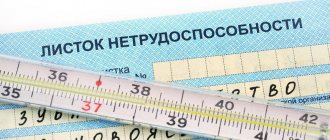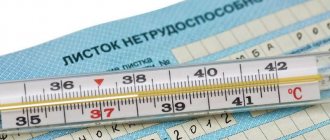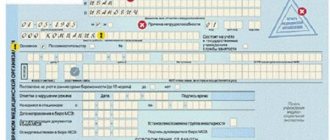What does a sick note contain?
A sick leave certificate differs from a certificate in that it has a unified form and is drawn up on special paper. The front side contains information about a specific person; on the back side there are decoding codes.
At the medical institution, the sheet is filled out by the attending physician. The following information should be reflected:
- code reflecting the cause of disability;
- short name of the institution, address and OGRN;
- date of issue;
- patient's personal data;
- information about whether sick leave will be issued at the main place of work or part-time;
- period of illness;
- position, full name and signature of the attending physician;
- date of return to work;
- if sick leave is issued to care for a family member, their details and degree of relationship are entered.
The employer fills out the second section. Since payment of sick leave is related to wages, the accounting department checks the duration of the sick leave, the presence of the clinic’s seal and the doctor’s personal seal on the form. If all data is entered correctly, you need to fill out the second section:
- Name of the organization;
- main job or part-time job;
- registration number in the Social Insurance Fund (SIF);
- INN and SNILS of the employee;
- insurance experience;
- codes indicating the reasons for the emergence of the right to benefits;
- the amount of average earnings for calculating benefits;
- average daily earnings;
- total benefit amount;
- data of the head of the enterprise and the chief accountant.
After complete and correct filling out, the sheet is sent to the accounting department or human resources department, where sick leave payments are calculated.
Decoding disability codes
The most common code is cause of disability "01", indicating illness, but there are other types of disability:
- 02 – injury;
- 03 – quarantine;
- 04 – work injury;
- 05 – bearing a child;
- 06 – preparation of prostheses in the hospital;
- 07 – occupational disease;
- 08 – sanatorium treatment;
- 09 – caring for a relative or disabled person;
- 10 – poisoning;
- 11 – social diseases;
- 12 – illness of a child under 7 years of age;
- 13 – caring for a disabled child;
- 14 – illness of a child due to the introduction of a vaccine;
- 15 – HIV infection.
Additional codes
The basis codes for issuing sick leave have additional cells. They are designated as “additional code” and “change code”.

Additional codes contain additional encoded information:
- 017 – treatment in a specialized sanatorium;
- 018 – sanatorium-resort treatment due to injury at work;
- 019 – treatment at a research institute;
- 020 – additional maternity leave;
- 021 – disease or injury resulting from alcohol or drug intoxication.
ATTENTION! If there are no additions, you do not need to fill in the “additional code” cells.
“Izm code” is filled in with a two-digit disease code if the cause of the disease has changed.
Cause of disability “09” requires the use of additional codes. For example, if a family member is being cared for, then the code “09” is entered in the main field, and the following clarifying designations are entered in the additional field:
- 38 – mother;
- 39 – father;
- 40 – guardian;
- 41 – trustee;
- 42 – another relative who cares for the patient.
The following codings are entered into the regime violation cells:
- 23 – violation of the regime, leaving the hospital, traveling for treatment to another area;
- 24 – failure to show up for a doctor’s appointment;
- 25 – going to work without written permission from a doctor;
- 26 – refusal to appear before the medical and social examination authorities;
- 27 – late appearance at the medical and social examination authorities;
- 28 – other violations.
The health worker also fills out the “Other” section, which contains the following codes:
- 31 – issuance of a new sick leave certificate if the employee continues to be ill;
- 32 – disability;
- 33 – change in disability category;
- 34 – death;
- 35 – refusal to conduct an examination;
- 36 – failure to show up for an appointment, and at a subsequent appointment the patient was declared able to work;
- 37 – referral for follow-up treatment after hospitalization.
Decoding hospital codes in Belarus. What you need to know about disability certificate codes
It is possible to include many types of codes; at the same time, both health workers and accountants or personnel officers of organizations must enter the codes.
Understanding the codes is not as difficult as it seems at first
, you just need to know where to find the information you need.
The sick leave certificate, although small in size, contains a huge amount of information:
- about the patient (personal data);
- about the medical institution that issued the sick leave;
- about the employer;
- about the type of work;
- about the employee’s health;
- about his illness.
Moreover, each item is divided into sub-items, which cannot be described in a fairly small format.
Encoding is used to compress information while storing it.
Complete instructions for using codes (with their designations) are contained in Order No. 624n. This document explains in detail:
- what the doctor fills out;
- that of a personnel officer or an accountant of the employer.
From the part filled out by the doctor, the personnel officer can glean a lot of information about the sick employee of the company, for example:
- whether he is disabled (in this case, it is necessary to register disability in personnel documents and review the work function);
- Is the disease dangerous for the team?
How to read codes?
The sick leave has the following line: “reason for incapacity for work.” The line contains cells for entering two-digit codes, which are filled out by the doctor.
The codes indicate the reason for which sick leave is issued to the employee. Here are the reasons and designation codes:
- general illness – 01;
- (outside work) – 02;
- quarantine (being among infectious patients) – 03;
- or its consequences – 04;
- maternity leave – 05;
- prosthetics in hospital – 06;
- occupational disease – 07;
- sanatorium treatment – 08;
- – 09;
- poisoning – 10;
- sick leave due to a child’s illness – 12;
- socially significant disease – 11.
In this case, three-digit additional codes can also be indicated:
- stay in a special sanatorium – 017;
- stay at a research institute – 019;
- additional maternity leave – 020;
- in case of illness resulting from intoxication (alcoholic or other) – 021.
If the cause of illness with code 11 is indicated on the sick leave, it means that there is a dangerous illness that can cause critical harm to both the sick person and others.
The coding of such diseases occurs on the basis of Decree No. 715, which came into force at the end of 2014.
Codes of dangerous diseases
Every state cares about the health of the planet's population. In order to summarize information about the causes of diseases in the population, WHO developed the ICD - the international classification of diseases.
Today, the ICD is a document recognized by all countries of the world; in Russia it was adopted for use at the end of the last century. Today, the 10th version (revision) of the ICD is in use.
Information about diseases and their causes is updated once every 10 years, and its next revision is scheduled for 2021
. When registering sick leave, not the entire multi-volume ICD database is used, but only those inclusions that contain important information about dangerous diseases.
At the same time, the codes themselves are not written on the sick leave, but code 11 in the line with the cause of the illness should alert you.
Dangerous diseases with code designations are divided into 2 types:
- socially significant diseases;
- dangerous to others.
The list of codes is presented in tables.
String "other"
A line with this title may contain important information regarding the employee's disability. You need to pay attention to the codes:
- 32 – recognition of disability;
- 33 – change of group for a disabled person.
The fact is that the disabled person himself may not provide information about his status at work, but if his rights (as a disabled person) are violated, the organization is waiting.
In order not to be guilty without guilt, you need to take note:
- a disabled person must (but is not required) to bring a rehabilitation card to work (it describes the criteria for possible work, for example, restrictions on carrying heavy objects or a ban on “standing” work);
- disabled people are entitled to other benefits at work;
- if the card is not provided, you need to take a receipt from the disabled employee stating that he is independently responsible for his health, subject to refusal to provide IRP.
Line 43 “Neurological manifestations of cervical osteochondrosis” includes spondylosis with anterior spinal or vertebral artery compression syndrome (M47); spondylosis with myelopathy (M47); lesions of the intervertebral disc with myelopathy, radiculopathy (M50); cervicocranial syndrome (posterior cervical sympathetic syndrome) (M53); cervical-brachial syndrome (M53); cervicalgia (M54).
Line 23 “Other cerebrovascular diseases” includes occlusion and stenosis of the precerebral (I65) and cerebral (I66) arteries that do not lead to cerebral infarction; other cerebrovascular diseases, including dyscirculatory encephalopathy (I67); transient cerebral ischemic attacks (G45).
Disease codes on sick leave
Please note that the disability codes on the sick leave certificate
reflect typical situations that are important for the employer.
Disease codes on sick leave certificates
indicate not only difficulties for workers, but also for their relatives, whom they care for. Moreover, some diseases are not indicated at the request of the employee.
Also see “How to pay for sick leave for child care under the new rules.”
For example, disease code “01” on a sick leave certificate
simply means illness.
If a company employee with a general illness asks for help, they enter code “01” on the sick leave certificate, which means
for the employee that they will be paid in full for such illness.
The sick leave code “01”
will tell the accountant how to calculate the payment.
Diagnosis on sick leave
Well, she’s unlikely to go to court, most likely she’ll quit out of harm’s way, but surely diagnoses shouldn’t be written on sick notes? Or can they? That is, you need to specifically ask the doctor not to indicate the diagnosis on the sick leave certificate? Does he have the right to do this and will they accept sick leave without a diagnosis at work?
She works in a confectionery factory, recently caught shingles from a neighbor’s cat and was on sick leave for some time (she said at work that she had a sore throat).
I got caught up in closing the sick leave and didn’t notice that the doctor wrote a diagnosis on it.
But the management, on the contrary, was not lazy, and considered this diagnosis, now they are practically forcing her to resign, accusing her of uncleanliness and all mortal sins.
How to correctly enter disease codes on a sick leave sheet
Currently, on sick leave certificates, the doctor does not indicate what the employee was ill with.
In order to maintain medical confidentiality, sick leave certificates use digital coding of diseases, which provides only the necessary information about the disease that the employer may need.
It also provides information about other important facts during the period of the employee’s incapacity for work. This article will tell you what information disease codes contain on sick leave, how they are entered, and what significance they have when filling out a sick leave.
The employer's goal, first of all, is to enter information about the amount of benefits that the employee should receive on the basis of sick leave.
The employee’s length of service and the amount of his average earnings are indicated here, as well as the amount of benefits the employer pays (the first three days of the period of incapacity for work) and the amount of benefits paid from the Social Insurance Fund.
Enter the site
2.2. bring to the attention of the management the approved Explanations on the coding of diagnoses of diseases and other causes of disability in certificates of incapacity for work to all medical institutions in the region (city), regardless of departmental affiliation.
Sick leave codes and their interpretation
In connection with the new requirements for filling out sick leave, changes have been made to the 1C: Salaries and Personnel Management 8 program (starting from version 2.5.37) - now in this program you can fill out sick leave on a computer.
Since 2011, sick leave has been filled out by both the doctor (first and third, tear-off sections) and the employer (second section). At the same time, the doctor does not have the right to make mistakes or cross-outs when filling out the form; if he made a mistake somewhere when filling out the sheet, he must take a new form and fill it out again.
When an employer fills out a sick leave sheet, he can make mistakes (although this is highly undesirable): incorrect information is carefully crossed out, and the correct information is written on the back of the sick leave sheet and certified by the signature of the person who made the correction.
The date the entry was made is also indicated and the company seal is affixed.
An unfilled sick leave sheet or a sheet filled out with violations cannot be the basis for payment of temporary disability benefits.
At the same time, the Social Insurance Fund explained that careless filling of the sheet, for example, entries in capital letters that go beyond the margins, etc., provided that the text can be read, are not grounds for non-payment.
In the future, payments for temporary disability are provided entirely at the expense of the Social Insurance Fund (currently the first three days are paid for at the expense of the policyholder, that is, the employer), as well as the transfer of sick leaves completely into electronic form.
How to find out a disease by code on a sick leave certificate
- Basic
– the main cause of disability is indicated. It consists of two parts of digital values.
First
– national coding of the disease, written in the form of two Arabic numbers – 01, 02, 03, etc.Second part,
represents an international system of records according to the accepted ICD-10 system.
The inclusion and mandatory completion of the second part of the coding in the document makes it possible to submit it to international companies, and for a doctor to fill out only one form;
- Additional cipher.
It indicates designations if, for example, the injury was sustained by an employee while drunk. In this case, the benefit payable is reduced; - Family connection.
Indicated if the sick leave was to care for a child or relative.
- Ensure the inviolability of personal information about the health status of citizens. The code carries only general typical information, without specifying the type of illness, its form, etc. information;
- For the convenience of tracking employee time. The doctor’s handwriting is difficult to decipher; the encoding makes it easier for the HR and accounting departments to read the sheet and perceive the information;
- Saves paper and time to fill out the sheet.
Decoding diagnoses on sick leave: what does code 01 mean?
What does sick leave mean? With the help of a sick leave certificate, an illness, injury or other physiological problem of an employee is registered. The form is sometimes called differently - a sheet of temporary incapacity for work.
It is allowed to be prescribed only by doctors who have passed a special check by the FSS. An employee can count on payments if the form was correctly filled out and submitted to the enterprise administration within the established time frame.
- “01” - disease, the most common case, especially during influenza epidemics;
- “02” - domestic injury, that is, damage to the body received outside of work/workplace;
- “03” - quarantine, indicates the need for quarantine, typical for infectious diseases, for example, tuberculosis;
- “04” is a work injury, but the correct name would be “work accident”;
- “05” - the onset of disability due to pregnancy and childbirth;
- “06” - prosthetics, which (for medical reasons) can only be performed in a hospital;
- "07" - prof. disease, as well as exacerbation of prof. diseases, especially typical for industries with hazardous conditions;
- “08” - medical procedures in hospitals and sanatoriums;
- “09” - disability due to the need to care for a sick family member (for example, a disabled person);
- “10” - poisoning, as well as other conditions;
- “11” is a disease from the list of social services. significant diseases, the list is approved by Government Decree N715. These include, in particular, tuberculosis, hepatitis, HIV, diabetes, oncology;
- “12” - the reason is the illness of a child under 7 years old, the need for additional care;
- “13” - caring for a disabled child;
- “14” - cancer in a child or a post-vaccination complication;
- “15” – HIV infection in a child.
Decoding the diagnosis
Resolution of the Ministry of Statistics and Analysis of the Republic of Belarus dated June 1, 2001 N 31 approved state statistical reporting in form N 16-VN “Report on the causes of morbidity in the employed population with temporary disability” (National Register of Legal Acts of the Republic of Belarus, 2001, N 62 , 8/6253), and the correct spelling is VN, not CHN - as you wrote!
3. Recognize as invalid the orders of the Ministry of Health of the Republic of Belarus dated December 6, 2000 No. 54 “On approval of the list of diseases, injuries and other causes of temporary disability included in the new form of statistical reporting” and dated December 31, 1999 No. 396 “On approval Instructions for encoding disease diagnoses on sick leave certificates.”










